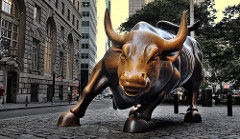Bias
Why Smart People Make Dumb Mistakes With Their Money: Part 1
Cognitive biases can lead to bad investment decisions
Posted July 12, 2016

Buy low, sell high. Were it so easy! When it comes to investments, many of us are swayed more by feelings and intuition than by sound judgment. The Minute Therapist does not offer stock tips, but it draws attention to the risks posed by implicit cognitive biases on an investor’s bottom line. Here are some examples:
1. Masters of the Universe Fallacy
What it is: Thinking we know more than we really do.
Comment: We overestimate our ability to pick winners and shed losers. We think we see patterns in stock-market movements where there are none.
2. Self-Serving Bias
What it is: The tendency to take credit for our successes and explain away our failures.
Comment: There's an old market saying, “Don't confuse brains with a bull market.”
3. Inertia Bias
What it is: Operating on the belief that things will stay as they are.
Comment: Believing that what goes up, stays up, or what goes down, stays down. However, the fact is that things stay the same until they don't.
4. Fixedness Bias
What it is: The tendency to continue to do the same thing, despite evidence that it is no longer working. (Otherwise known as Einstein's definition of insanity)
Comment: You continue to buy stocks that were the darlings a few years back, but whose growth has come and gone.
5. The Personalization Fallacy
What it is: When the price of a stock plummets, we believe the fall is directed at us personally.
Comment: Investors may personalize their investments, believing they are being punished when a stock slides. When we personalize events that have nothing to do with us, we base our judgments on whether we feel deserving of praise or punishment, not on the evidence at hand.
6. Regret Theory
What it is: Investors resist taking a loss because it stands as proof that their first judgment was wrong.
Comment: People hold losing investments long beyond there is any sound reason to continue to hold them. Contrary to the dictates of rationality, investors are prone to let their losses ride (sometimes all the way to the ground).
7. Pain Outweighs Gain
What it is: Placing different emotional weights on gains and losses. Individuals experience much greater distress after losses than happiness after equivalent gains.
Comment: The emotional arithmetic here is that money lost is twice as important as money gained. Behavioral economists believe that investors typically consider the loss of $1 dollar to be twice as painful as the pleasure received from a $1 gain. Investors have an aversion to taking losses when stocks decline. Consequently, they hold losers far too long and sell winners far too quickly in order to minimize the pain of a realized loss.
What it is: Basing investment decisions on the availability of information that comes readily to mind.
Comment: Buying the stock of a company that is currently in the news may lead to investment decisions based on momentary fluctuations rather than underlying fundamentals. Moreover, publicly reported news is most likely already baked into the stock’s current price.
9. Hindsight Fallacy
What it is: The tendency to look back on something that’s already happened as though it had been inevitable and therefore predictable.
Comment: The hindsight fallacy leads to exaggerated confidence in one’s ability to forecast future events. People say to themselves after a market correction, “Now I know better. Now I know the signs when to get out.” Really?
10. Identification Bias
What it is: The tendency to personally identify with stocks you own.
Comment: Investors will sometimes use the collective "we" to refer to stock movements, as in "We had a good day" or "We can do better next quarter." Another well-known market saying bears repeating, “The stock doesn’t know you own it.”
(more to follow in next post)
© 2016 Jeffrey S. Nevid




